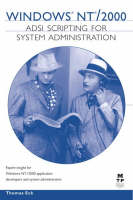
Windows NT/2000 ADSI Scripting for System Administration
Sams Publishing (Verlag)
978-1-57870-219-0 (ISBN)
- Titel ist leider vergriffen;
keine Neuauflage - Artikel merken
Scripting provides system administrators an optimal means of automating tedious and time-consuming application, configuration, and management tasks. In addition you can take advantage of new capabilities offered by VBScript, ADSI and Windows Scripting Host. ADSI is particularly important in light of the upcoming release of Windows 2000, as it provides a means of accessing functionality in the Active Directory Microsoft's highly-publicized directory service. ADSI allows for cross-functionality with directory services in other computing platforms, which is critical since 90% of all enterprise networks comprise multiple platforms. This book will provide system administrators with solutions to automate and simplify the configuration and management of their networks. The author will present expert tips, code development and proven in real-world enterprise environments.
Thomas Eck (ASE, CCA, CNA, GCA, MCDBA, MCSD, MCSE+I) is a specialist with Perot Systems Corporation in the Global Financial Services industry division. Currently, he is working as a Systems Architect and project manager on contract with a major European investment bank. His unique role at the bank allows him to define the global implementation standards employed for the bank's intranet and extranet Web infrastructure. As part of this role, he leads a group charged with the research and development of new and innovative ways to solve workflow and interoperability issues using Web and thin-client technology. Additionally, Thomas provides support and consultation to the various global development, engineering, and deployment teams within the bank environment. Outside the office, Thomas has served as a contributing author and editor of several titles for Osborne McGraw-Hill and Charles River Media, and also contributes regularly to MCP Magazine. When he is not engulfed in writing, work, or studying for an industry certification exam, Thomas and his wife can usually be found spending time with family, traveling, going to the theater, or creating fabulous culinary creations at their home near Chicago. Thomas always welcomes questions and feedback regarding his work¿ if you want to reach him directly, feel free to drop him a note at thomas.eck@ps.net.
(NOTE: Each chapter concludes with a Summary.)
Introduction.
I. PREPARING FOR PROGRAMMATIC ADMINISTRATION.
1. Overview of the Active Directory Service Interfaces (ADSI).
ADSI Abstracts Namespace Manipulation. Practical Usage of ADSI. Interface Support. Applied Theory: Using ADSI to Migrate from Windows NT 4.0 to Windows. 2000.
2. Making the Transition: Multi-Tier Development for System Administrators.
Why Visual Basic? Establishing the Development Environment. Configuring the Visual Basic Environment. Testing Code Segments in a Non-Critical Environment. Using ADSI and Visual Basic Interactively. Developing a COM Server Using Visual Basic and ADSI.
II. EXPLORING THE ADSI SERVICE PROVIDERS: WINDOWS NT.
3. Container Enumeration Methods and Programmatic Domain Account.
Policy Manipulation Enumerating Domains in the Windows NT Namespace. Managing Windows NT Domain Properties. Enumerating Objects Within a Domain or Computer. Creating and Deleting Objects Using IADsContainer. Creating the NTContainerManagement Class Module.
4. Programmatic User Account Manipulation.
User Object Binding Syntax. Managing User Account Properties. Manipulating User Environment Profiles. Manipulating User Login Hours. Manipulating a User Login Workstation. Manipulating Account Properties. Manipulating the Parameters Property. ADSI Exposed Properties that Cannot Be Manipulated Using Standard GUI Tools. Creating the NTUserManagement Class Module.
5. Programmatic Group Manipulation.
Windows NT Security Group Administration. Using Groups to Manage File System Security.
6. Programmatic Computer and Service Manipulation.
Querying Computer Properties: The IADsComputer Interface. Querying and Manipulating Computer Services: The IADsService Interface. Querying and Manipulating Service Operations: The IADsServiceOperations Interface. Creating the NTComputerManagement Class Module.
7. Programmatic File and Print Resource Management.
Managing File Resources. Managing File Sessions. Managing Open Resources. Managing Print Resources. Creating the NTResourceManagement Class Module.
III. EXPLORING THE ADSI SERVICE PROVIDERS: IIS.
8. Programmatic Management of the IIS Metabase.
IIS Metabase Structure. The IIsComputer Object. IIS Site Logging. Programmatic Site Management. Programmatic Site Operations. Creating the IIsSiteManagement Class Module.
9. Programmatic Management of Web Site Properties.
Virtual Site Binding. Virtual Directory Binding. Property Inheritance. Programmatically Administering the Web Site Property Sheet. Programmatically Administering the Web Operators Property Sheet. Programmatically Administering the Web Performance Property Sheet. Programmatically Administering the Home Directory Property Sheet. Programmatically Administering the Documents Property Sheet. Programmatically Administering the Directory Security Property Sheet. Programmatically Administering the HTTP Headers Property Sheet. Creating the IIsWebManagement Class Module.
10. Programmatic Management of FTP Site Properties.
Determining Property Inheritance. Programmatically Administering the FTP Site Property Sheet. Programmatically Administering the Security Accounts Property Sheet. Programmatically Administering the Messages Property Sheet. Programmatically Administering the Home Directory Property Sheet. Programmatically Administering the Directory Security Property Sheet. Creating the IIsFTPManagement Class Module.
IV. EXPLORING THE ADSI SERVICE PROVIDERS: LDAP.
11. Programmatic Management of LDAP Infrastructures.
A Brief Overview of LDAP Technology and Terminology. Available LDAP APIs. Commercial Products Supporting LDAP. Applied Theory: Installing the Netscape Directory Server. Manipulating an LDAP Directory Using ADSI. Using ADO to Search an LDAP Directory Using Visual Basic. Managing Microsoft Exchange Mailboxes and Distribution Lists Using. ADSI's LDAP Provider. Creating the LDAPObjectManagement Class Module. Creating the ExchangeObjectMgt Class Module.
12. Programmatic Management of the Windows 2000 Active Directory.
Active Directory Terminology Primer. Binding to Objects in the Active Directory. Manipulating Objects in the Active Directory. Creating Objects in the Active Directory. Removing Objects from the Active Directory Using Visual Basic. Managing Security for Objects in the Active Directory. Creating the ADObjectManagement Class Module.
V. APPENDIXES.
Appendix A. VBScript Code Reference.
Chapter 3: Container Management Code. Chapter 4: User Management Code. Chapter 5: Group Management Code. Chapter 6: Computer and Service Management Code. Chapter 7: File and Print Service Management Code. Chapter 8: IIS Site Operations Code. Chapter 9: IIS Web Site Operations Code. Chapter 10: IIS FTP Site Operations Code. Chapter 11: LDAP Infrastructure Management Code. Chapter 12: Windows 2000 Management Code.
Appendix B. ADSI 2.5 Programmer's Reference.
AccessControlEntry Interface. AccessControlList. IADs Interface. IADsCollection. IADsComputer. IADsContainer. IADsDeleteOps Interface. IADsDomain. IADsFileService. IADsFileServiceOperations. IADsFileShare. IADsGroup. IADsLocality. IADsMembers. IADsO Interface. IADsOU Interface. IADsOpenDSObject. IADsPrintJob. IADsPrintJobOperations. IADsPrintQueue. IADsPrintQueueOperations. IADsResource. IADsService. IADsServiceOperations. IADsSession. IADsUser. Custom WinNT Properties. WinNTSystemInfo.
Appendix C. Further Reading.
Active Directory Design and Administration. Active Directory Service Interfaces (ADSI). Active Server Page (ASP) Scripting. ActiveX Data Objects. Lightweight Directory Access Protocol (LDAP). Visual Basic.
| Erscheint lt. Verlag | 29.3.2000 |
|---|---|
| Verlagsort | Indianapolis |
| Sprache | englisch |
| Maße | 153 x 229 mm |
| Gewicht | 969 g |
| Themenwelt | Informatik ► Betriebssysteme / Server ► Windows |
| Informatik ► Betriebssysteme / Server ► Windows Server | |
| Mathematik / Informatik ► Informatik ► Netzwerke | |
| Informatik ► Weitere Themen ► Hardware | |
| ISBN-10 | 1-57870-219-4 / 1578702194 |
| ISBN-13 | 978-1-57870-219-0 / 9781578702190 |
| Zustand | Neuware |
| Haben Sie eine Frage zum Produkt? |
aus dem Bereich


